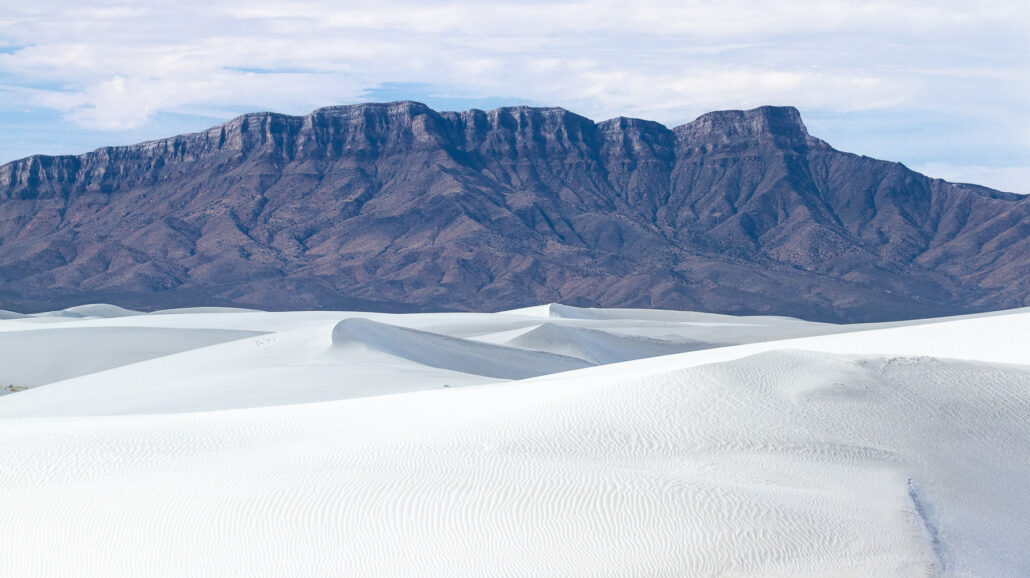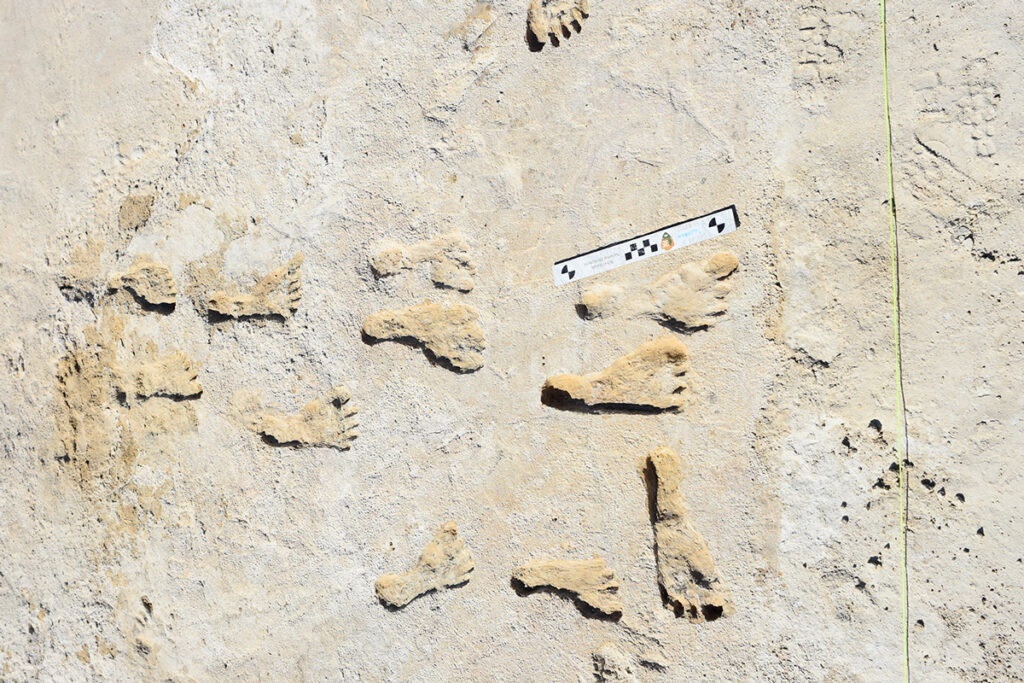
For years, archaeologists said we can trace the beginnings of human settlement in the Americas to at least 12,000 years ago. That’s about when wanderers from Asia first crossed the Bering Land Bridge into North America, eventually settling all of the New World, these experts assured us.
The available fossil evidence originally indicated about 12,000 years of human habitation in the Western Hemisphere. Now, new data from the fossil record proves that humans crossed over from Asia much earlier than this, pushing back the date of the first Bering crossing by more than 10,000 years.
The original estimate of 12,000 years ago as the timing of humanity’s first voyages in the Americas was partially upended a few years back after a research team from the United States Geological Survey (USGS) unveiled evidence from White Sands National Park challenging this conventional view. Their evidence, they said, nearly doubled the estimate for how long humans have lived in North America.
But skeptics were left unimpressed and demanded better proof. So, the USGS research geologists based in Denver are providing what these skeptics demanded—irrefutable evidence that humans walked the shores of an extinct lake in New Mexico at least 23,000 years ago.
That’s not all they uncovered.
Fossil footprints analyzed and dated by the team show ancient humans and ground sloths, mammoths, and other extinct megafauna mingling and interacting with one another, sharing the same spaces at the same times. Human and animal footprints overlap and trace the same landscapes, providing a window into the lives of these Paleolithic North Americans.
“Humans stepping on animal tracks, animals stepping on human tracks,” said USGS research geologist Kathleen Springer. “We’re getting remarkable glimpses in behavioral interactions between the two.”
Two USGS scientists provided a vivid and detailed explanation of their findings to an online audience during a recent public lecture. During her presentation, Springer called the astonishing findings “snapshots in time into the lives of living and breathing animals and humans,” past vignettes “that could never be achieved by studying fossil bone or finding artifacts alone.”
Footprints on the muddy shore of a long-lost lake
At an undisclosed location at White Sands National Park, a section of the park off-limits to the public, USGS and National Park Service authorities are carefully documenting and studying thousands of fossil human footprints lying at the surface and thousands more lying buried beneath. The prints exposed at the surface will eventually be lost to time forever to wind and rain; thus, a rush is on to document and understand them while there’s still time.
Springer said the site amounts to no less than one of the most unique and rich fields of fossil footprints discovered. “In a nutshell, humans and extinct Pleistocene animals are being discovered there,” she said, “remarkably, not in the form of their bones, as you would think, but in the form of their footprints.”
The remarkable discovery was first detailed in a research paper published just before the global COVID-19 pandemic.
The pandemic prevented the team from continuing their work at the site, efforts to find further evidence that might better shore up their case for 23,000 years of human history at White Sands. Critics argued that the method they used to estimate the date of the footprints wasn’t reliable enough. There was great reluctance to let go of the impression that the first humans to step foot in North America arrived some 12,000 years ago as revealed by the discovery of the famous Clovis and Folsom points.
Jeff Pigati, a USGS research geologist who presented the findings alongside Springer, said the end of the pandemic allowed his team to not only return to the location of the footprints but to excavate. They dug deeper into the surrounding strata to study deeper layers of human footprints and to determine their antiquity through carbon-14 dating.

The humans, mostly teenagers and children but also adults, left footprints in the mud flats of a great Pleistocene-era lake. The lake is now extinct—it eventually dried up completely, leaving a vast swath of gypsum dunes behind, the famous White Sands.
The individuals who made the prints were all barefoot at the time, leaving no doubt that it was people who made them and not animals. “We’re documenting nearly 2,000 years of human visitation at White Sands,” Pigati said.
Ancient interactions revealed
Pigati explained how his team managed to confirm that the human footprints were made some 23,000 years ago.
The trick, he said, was to isolate, clean, and then process ancient pollen grains left next to the footprints at the same time. The relative ages of the ancient pollen grains can be measured by measuring carbon-14, a radioactive isotope that begins decaying when living tissues die.
Carbon-14 decays at a precise rate; the isotope has a half-life of 5,730 years. Measuring the amount of remaining carbon-14 in organic material can reveal how old a sample is.
Samples of pollen and other useable organic material were cleaned, the radioactive carbon was extracted, and after further cleaning the isolated carbon matter was converted into pure graphite and prepared for processing in a radiocarbon dating machine. Multiple samples of organic matter contemporaneous to the fossil human footprints were tested and the same results were returned over and over again, Pigati said.
“When we got the dates back, needless to say, we were stunned because the ages came back between 23 and 21,000 years old,” he said. “Now, let that sink in a minute. That’s 8 or 10,000 years older than Clovis.”
More information can be gleaned from the footprint evidence.
In addition to their antiquity, the prints contain clues to the behaviors of the individuals who left them in the mud some 21,000 to 23,000 years ago.
For instance, one set of prints showcased by the research duo was found to have been left by a woman carrying a small child. The researchers know this because of the size of the footprints and also for the fact that one tiny set of a toddler’s prints was left when the women set the child down for a moment. She must have immediately picked the child back up again, as there’s only one set of child footprints left in the sequence, which shows that this woman carried the child back to where they came from.
Another set of prints reveals clear evidence of lively interaction between multiple humans and a giant ground slot trying to escape. The sloth quickened its pace when the humans began pursuing it. The sloth also stopped, turned to face the Homo sapiens, reared up on its hind legs, and then ran in a loop before fleeing the lake shore. Its ultimate fate is unknown.
Human footprints can also be found inside mammoth footprints, clear evidence that these people were following these giant lumbering beasts. All species of mammoth on Earth became extinct about 4,000 years ago when the last surviving herd perished on an island in the Russian Arctic.
Footprints of extinct species of wolves, cats, sloths, camels, horses, a species of short-faced bear, and more were all left behind in the ancient mudflats some 23,000 years ago alongside the human prints.
“You would not believe how many mammoth footprints there are,” Springer said. “You can actually see mammoth footprints on Google Earth if you know where to look.”
Pigati said the dating uncovered by the radiocarbon evidence is irrefutable. They tested samples of ancient conifer pollen, controlling for any potential ways that groundwater might have moved or obscured its age. They further backed up this evidence with luminescence dating. Over and over again, the dates matched: organic material left at the same time and in the same place as the footprints are up to 23,000 years old.
“You can’t argue that all three of these dating techniques gave incorrect ages that just happen to match to each other,” said Pigati. “It just doesn’t work that way.”
A new story of human migration to the Americas
The evidence from White Sands National Park shows conclusively that people lived, hunted, and foraged across North America for thousands of years longer than we previously realized. The history of human settlement in Central and South America almost certainly extends farther back in time, as well.
The original story told of a band of wanders who took advantage of a receding Ice Age and the Bering Land Bring to cross from the Eurasian continent into what would eventually become Alaska. Archeologists speculate that these ancient travelers were probably following animals they hunted, entirely unaware that they had crossed over from the Old World into the New.
The footprints left at White Sands National Park paint an entirely different picture.
Springer and Pigati said a better explanation would be that humans followed ice-free corridors either along the coast of Alaska or bisecting the state, leading to portions of British Columbia further south and eventually to areas entirely free of the massive Ice Age ice caps. The melting glaciers fed water to lakes and riparian systems where an abundance of flora and fauna thrived, sustaining human settlers for centuries.
Human settlements expanded and then disbursed as the population grew and as groups were compelled to seek new hunting and foraging grounds whenever rising human population numbers resulted in the depletion of existing resources. The process of the peopling of all the Americas began at least 23,000 years ago, or some 20,000 years after the last Neanderthals were believed to have become extinct, leaving only one remaining hominid species to eventually conquer the globe.
There’s still more to learn from the ancient human footprints in New Mexico. “We’re continuing to work on the original site,” Springer confirmed.
Pigati argued that what he and his colleagues are revealing at the national park is likely just the tip of the iceberg. He said the date of humanity’s first steps into Alaska almost certainly stretches back even farther in time.
“If people were here 23,000 years ago during the last glacial maximum, when ice sheets covered much of North America and essentially blocked passage of people migrating from Asia,” he said, “then the people had to have been here prior to that, and in sufficient numbers to make a population that sustained itself for that long, for the 2,000 years that we’re documenting here.”
©2025 Public Parks
Park Info
Park Name:
White Sands National Park
Location:
New Mexico, USA
More Information:



